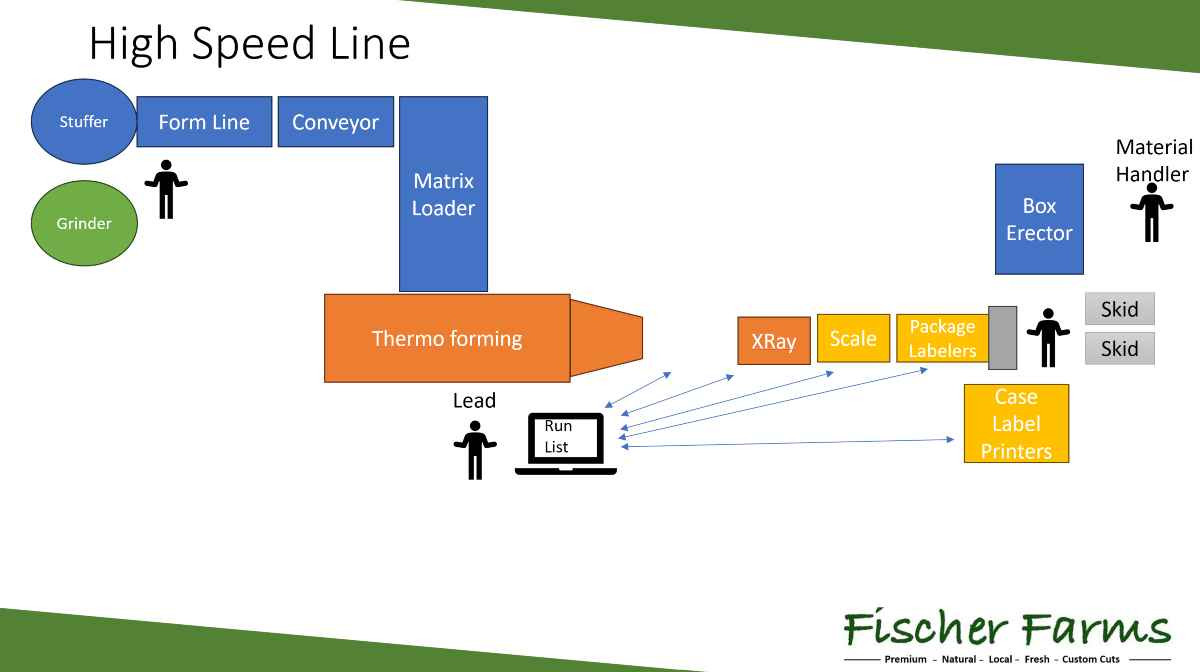Made to Order Supply Chain for Regional Meat Systems
posted on
January 3, 2025
Fischer Farms has worked with industry leaders to develop a made to order processing facility supply chain for regional meat systems to better compete with the very large processing plants and deliver fresh meats to their customers. It is our goal through the Ultimate Beef Research Project to learn and share how our efficiencies can help others.

Existing Beef System
Producing beef has become a complex supply chain in the United States that typically involves lean beef brought in from Brazil and other countries. The butchering of beef has been consolidated to just a few large plants across the US that butcher 6,000 head per day or more in a single location. While the plant operations are efficient the cattle to supply these plants must be shipped great distances and spend long hours on trucks. Then, the meat is shipped to processing plants for further processing to cut steaks and produce other products such as ground beef patties. The products are then shipped as a finished good to distributor warehouses. This supply chain covers many states, and the plants are concentrated in the central United States, close to the huge feedlots.
Local Supply Chains – Regional Food Systems
Fischer Farms realized 20 years ago that an improved supply chain that is close to the farm and the customer can eliminate wasteful trucking across multiple states with superior product quality. There are only small custom butcher shops in Indiana, Kentucky & Ohio where farmers can take 1-2 cattle in at a time to sell to family and friends. Over 20 years Fischer Farms has built an efficient and local supply chain that processes beef raised on local farms and is sold directly to restaurants, universities and K-12 schools through the region. The system has grown to processing 40-50 beef and 90 hogs per week and delivered fresh to over 200 wholesale customers.
This system supports local communities with over 35 employees across the two businesses of Fischer Farms and Sander Processing. This system is much easier on the cattle as they usually travel only a few miles and don’t wait on the trucks at all. 95% of the product processed each week is cut for a specific customer to eliminate the need for a finished goods inventory and to quickly get the fresh meat to the customer. But this system is more labor intensive in the further processed market than the big plants. The equipment used in small plants is not efficient and initially designed for running just a few beef at a time. This puts the small plants at a severe cost disadvantage.
Made-to-Order Further Processing
Fischer Farms started working with experienced industry equipment experts to design a new system for medium sized plants that will improve upon the existing made-to-order model. The new system will use high speed processing with an order management system that feeds orders to the shop floor system and are produced, labeled and shipped with minimal manual labor. Dave Fischer worked for 15 years developing and managing supply chain software implementations in steel, electronic, and semiconductor companies. After he and his wife moved back to his home farm in 2002, they started the meat business in 2004. He developed a robust order and process management system in 2013 and has repeatedly updated its capabilities. In 2022 he added Electronic Data Interchange to allow larger customers to directly send orders and receive invoices electronically. This protocol will integrate with the new shop floor system with the goal of almost eliminating human handling with orders being processed and filled directly.
The new high speed burger line can run at 4 patties per second and is directly linked to packaging and labelling. This line can also be used for other cuts such as steaks, sausage, stew meat, bulk grinds or roasts. The package produced is labelled to customer specs and already boxed with the distribution routing information on each box.
This combines the typical processing and order fulfillment steps and will be 50% or more efficient than the current system. Lead times to customers will also be greatly reduced.
Mr. Silvio Weder has been in the packaging business for small and medium sized processing plants for the last 35 years. He is impressed with this vision and recently shared why he feels other plants have not created a similar approach. “When we met Dave Fischer he surprised us with his statement, ‘goal is 0 fresh meat inventory every night’.”
Dave worked closely with Mr. Weder and others from high-speed lines to packaging equipment to develop the planned system. Silvio continued, “Using advanced software to predict demand and automate decision-making while improving operational efficiency this will revolutionize food production in small to medium-sized butcher plants.”



